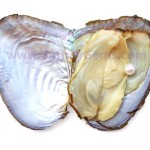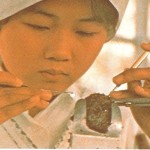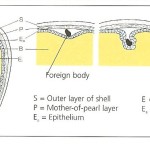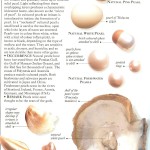Many of us now know now that pearls are formed in shellfish such as oysters or mussels. A natural defence against an irritant, (such as a grain of sand) creates a secretion by the mussel (argonite) and layers of nacre, secreted around the irritant build up like onion layers to gradually create the solid pearl. Over the centuries the skills to aid in the cultivation of pearls has been handed down through the generations. The process remains a delicate one. Highly skilled lab attendants cause the the mollusk to produce a pearl by insertion of a foreign body. It takes a few years of growth, depending on the diameter of the pearl required. As early as the 13th Century the Chinese created cultured mabes (blister pearls) by placing tiny objects (such as Buddhas) on the inner wall of the mollusk shell, (see my January 29th post) so they would become covered with pearl material. The full pearl however is created in the flesh (lips) of the oyster (see image below). The iridescent lustre, is referred to as the “Orient of Pearl”. Freshwater pearls are river pearls and Seawater pearls come from the ocean. A South Sea pearl is usually over 10mm. Depending on the sand in the area of cultivation the pearl result is Silvery White – Australia, Golden – Indonesia, and Black – Tahiti, although Australia has seen the beginnings of keshi-like (large black/green pearls) “in the rough” like “baroque” pearls, coming from a region in West Australia. Nearly all colours in freshwater pearls, other than the white, whitish pinks, some blues and creams are all “colour assisted” pearls, which makes them “Cultured Fresh Water Pearls”. A simple way I explain it, is, the irritant is saturated before insertion with a natural colouring agent (such as beetroot or spinach) and the nacre built up after this insertion is colour all the way through. It’s a bit unfortunate actually to see, that some lovely natural colour pearls are painted but these pearls end up having no value. Most stark white pearls are bleached, and although at a distance these pearls look striking, this process causes the once divine lustre to diminish. As a lover of pearls I like the natural baroque pearls best although the almost round have a place in the world for sure and are the most in demand. And sadly it seems the larger the better.
Some of the images below are from my Gemstone “Bibles”, Gemstones of the World – Walter Shcumann and Gem Stones – Cathy Hall




